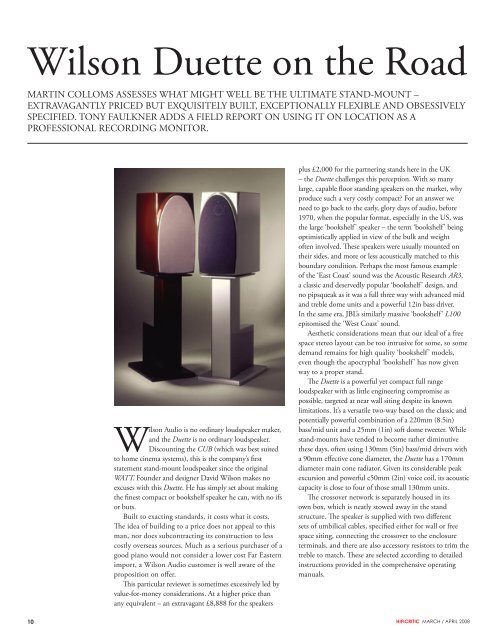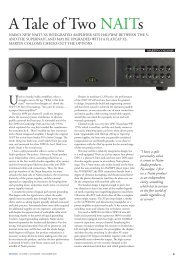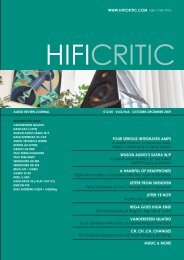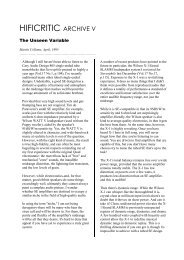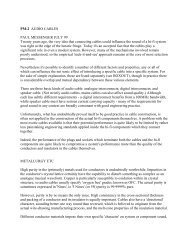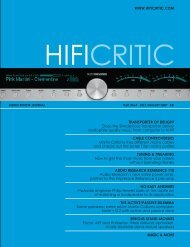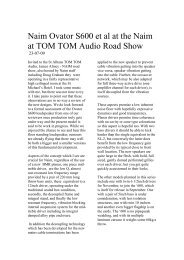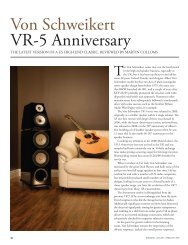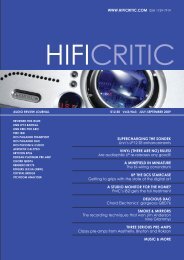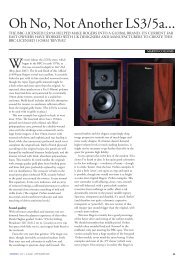HFC_issue8 1.indd - Hificritic.com
HFC_issue8 1.indd - Hificritic.com
HFC_issue8 1.indd - Hificritic.com
You also want an ePaper? Increase the reach of your titles
YUMPU automatically turns print PDFs into web optimized ePapers that Google loves.
Wilson Duette on the Road<br />
MARTIN COLLOMS ASSESSES WHAT MIGHT WELL BE THE ULTIMATE STAND-MOUNT –<br />
EXTRAVAGANTLY PRICED BUT EXQUISITELY BUILT, EXCEPTIONALLY FLEXIBLE AND OBSESSIVELY<br />
SPECIFIED. TONY FAULKNER ADDS A FIELD REPORT ON USING IT ON LOCATION AS A<br />
PROFESSIONAL RECORDING MONITOR.<br />
Wilson Audio is no ordinary loudspeaker maker,<br />
and the Duette is no ordinary loudspeaker.<br />
Discounting the CUB (which was best suited<br />
to home cinema systems), this is the <strong>com</strong>pany’s first<br />
statement stand-mount loudspeaker since the original<br />
WATT. Founder and designer David Wilson makes no<br />
excuses with this Duette. He has simply set about making<br />
the finest <strong>com</strong>pact or bookshelf speaker he can, with no ifs<br />
or buts.<br />
Built to exacting standards, it costs what it costs.<br />
The idea of building to a price does not appeal to this<br />
man, nor does subcontracting its construction to less<br />
costly overseas sources. Much as a serious purchaser of a<br />
good piano would not consider a lower cost Far Eastern<br />
import, a Wilson Audio customer is well aware of the<br />
proposition on offer.<br />
This particular reviewer is sometimes excessively led by<br />
value-for-money considerations. At a higher price than<br />
any equivalent – an extravagant £8,888 for the speakers<br />
plus £2,000 for the partnering stands here in the UK<br />
– the Duette challenges this perception. With so many<br />
large, capable floor standing speakers on the market, why<br />
produce such a very costly <strong>com</strong>pact? For an answer we<br />
need to go back to the early, glory days of audio, before<br />
1970, when the popular format, especially in the US, was<br />
the large ‘bookshelf’ speaker – the term ‘bookshelf’ being<br />
optimistically applied in view of the bulk and weight<br />
often involved. These speakers were usually mounted on<br />
their sides, and more or less acoustically matched to this<br />
boundary condition. Perhaps the most famous example<br />
of the ‘East Coast’ sound was the Acoustic Research AR3,<br />
a classic and deservedly popular ‘bookshelf’ design, and<br />
no pipsqueak as it was a full three way with advanced mid<br />
and treble dome units and a powerful 12in bass driver.<br />
In the same era, JBL’s similarly massive ‘bookshelf’ L100<br />
epitomised the ‘West Coast’ sound.<br />
Aesthetic considerations mean that our ideal of a free<br />
space stereo layout can be too intrusive for some, so some<br />
demand remains for high quality ‘bookshelf’ models,<br />
even though the apocryphal ‘bookshelf’ has now given<br />
way to a proper stand.<br />
The Duette is a powerful yet <strong>com</strong>pact full range<br />
loudspeaker with as little engineering <strong>com</strong>promise as<br />
possible, targeted at near wall siting despite its known<br />
limitations. It’s a versatile two-way based on the classic and<br />
potentially powerful <strong>com</strong>bination of a 220mm (8.5in)<br />
bass/mid unit and a 25mm (1in) soft dome tweeter. While<br />
stand-mounts have tended to be<strong>com</strong>e rather diminutive<br />
these days, often using 130mm (5in) bass/mid drivers with<br />
a 90mm effective cone diameter, the Duette has a 170mm<br />
diameter main cone radiator. Given its considerable peak<br />
excursion and powerful c50mm (2in) voice coil, its acoustic<br />
capacity is close to four of those small 130mm units.<br />
The crossover network is separately housed in its<br />
own box, which is neatly stowed away in the stand<br />
structure. The speaker is supplied with two different<br />
sets of umbilical cables, specified either for wall or free<br />
space siting, connecting the crossover to the enclosure<br />
terminals, and there are also accessory resistors to trim the<br />
treble to match. These are selected according to detailed<br />
instructions provided in the <strong>com</strong>prehensive operating<br />
manuals.<br />
10 HIFICRITIC MARCH / APRIL 2008
◆ REVIEW<br />
MARTIN COLLOMS<br />
TONY FAULKNER<br />
Technology<br />
Engineers will be impressed by the micro-grained, energydissipating<br />
lower surface of the brass cups, which sit<br />
between the enclosure’s hardened magnetic cones and<br />
milled recesses on the stand’s alloy top plate. The tripod<br />
coupling between enclosure and support is inherently<br />
self-adjusting, and the stand has generous, adjustable<br />
floor-coupling hardware. Between the milled alloy top<br />
and bottom plates, the stand has a massive non-resonant<br />
central pillar of ‘M’ material, a proprietary mineral-loaded<br />
polymer, locked in by tensioned, hardened steel bolts.<br />
The enclosure, made from the same tough yet well<br />
damped proprietary ‘M’ material, is singularly inert, and<br />
reinforced by <strong>com</strong>plex bracing. Providing the drivers with a<br />
firm foundation, the front panel is 50mm (2in) deep, and<br />
the material is so tough it may be threaded directly to take<br />
the driver fixing screws. Internal volume damping relies on<br />
a familiar <strong>com</strong>bination of acoustic foam pads and a well<br />
packed pad of fibre absorbent fixed behind the bass driver<br />
only, leaving the main volume unobstructed. Were that all<br />
loudspeakers were built as well as this one.<br />
Computer aided design was <strong>com</strong>bined with extended<br />
listening to design the crossover, which provides 18db/<br />
oct slopes for each driver at a lower than usual 1.8kHz<br />
frequency. External mounting makes the crossover largely<br />
immune from vibration and electromagnetic interference.<br />
To attain the 90dB sensitivity, it’s a 4ohm system, using<br />
a custom built SEAS Excel series 3.9ohm bass/mid unit<br />
with a unique cone, dust cap, termination and voice coil<br />
assembly. It has an open construction die-cast frame, and<br />
a <strong>com</strong>plex progressive non-resonant spider. The 3.6ohm<br />
tweeter is a well terminated soft dome from ScanSpeak,<br />
built on a massive alloy plate, solidly bolted to the<br />
enclosure, and with rear cavity back wave termination.<br />
Both drivers have conductive copper elements in their<br />
magnetic circuits to reduce eddy-currents and minimise<br />
distortion.<br />
Sound Quality<br />
I first heard a quartet of near wall mounted Duettes in a<br />
40 seat demonstration at last September’s Heathrow show,<br />
ably operated by Peter McGrath. I heard a convincing,<br />
generous, enveloping and focused sound field of fine<br />
bandwidth and exceptional dynamic range. At times Peter<br />
used the new Wilson subwoofer, but on one particularly<br />
impressive organ piece we then discovered that he had<br />
forgot to switch on the sub. ‘Who needs it?’ we said<br />
to a man. Later I popped over to Henry Wood Hall to<br />
hear them monitoring one of Tony Faulkner’s recording<br />
sessions, and was impressed by their dynamic and vibrant<br />
replay, and their grip on the live acoustic. (Tony reports<br />
separately on his Duette experiences.)<br />
The ex-dem review speakers were well run in and<br />
seemed free from strain from the moment they were<br />
installed. While the bookshelf option was not attempted,<br />
near-to-wall and free space locations were both tried.<br />
Initial listening with LPs was very civilised. One<br />
hallmark of a refined well blended deign is the ability to<br />
pay baroque music quite loudly. This sat <strong>com</strong>fortably with<br />
one facet of my consciousness, while allowing me to write<br />
down these observations without mental anguish.<br />
Despite the large physical disparity between the bass<br />
and treble drivers I could not hear the join between them.<br />
The sound is not spoiled with the grilles on, but I suspect<br />
most enthusiasts will leave them off for the ultimate level of<br />
micro detail and dynamic expression. Happily the drivers<br />
look reasonably finger-proof.<br />
In free space very good results are possible when used<br />
as suggested with the appropriate supplied cable and HF<br />
resistor, although the perfectionist might well still note a<br />
lightness to midrange tonality, and a thinning of voices.<br />
The lower registers of a piano are recessed, leaving the<br />
higher notes sounding somewhat coloured and boxy.<br />
Initially fretting over this, I thought that Wilson might<br />
well have considered a crossover option more objectively<br />
optimised for free space: perhaps a bit more inductance in<br />
HIFICRITIC MARCH / APRIL 2008 11
◆ REVIEW<br />
EQUIPMENT USED<br />
Conrad Johnson<br />
ACT2-2 pre-amp,<br />
Audio Synthesis Passion<br />
passive pre-amp, Naim<br />
NAP250, Conrad<br />
Johnson Premier 350SA,<br />
Linn LP12, Naim ARO<br />
tonearm, Koetsu Red<br />
T cartridge, Origin<br />
Live DC drive (top<br />
spec). Naim CDS3,<br />
Marantz CD-7 CD<br />
players. Kimber KS<br />
3035 speaker cable, Van<br />
den Hul First Ultimate<br />
interconnect.<br />
the midrange network, and a further tweak of the overall<br />
balance. However, free space use showed the high potential<br />
for a precision stereo image – well focused, deep and wide,<br />
with fine perspectives.<br />
Moving the speakers closer to a wall, I found that the<br />
immediate locality should not be cluttered. All positional<br />
adjustments must be carefully made: the left-to-right<br />
spacing, the angling and the actual spacing from the wall<br />
behind. Once achieved, the tonal balance was close to<br />
perfect here: the upper-to-lower midrange now sounded<br />
uniform, and the speaker really sang. Near the wall I have<br />
to admit that it sounded much better than I expected, and<br />
after an hour or so it actually became quite convincing.<br />
The Duette sounded even and well blended, highly<br />
articulate and with the sort of natural expressive dynamics<br />
that are usually the preserve of much larger speakers. It<br />
informs you how well a musician is playing, revealing<br />
nuances of timbre and expression, along with upbeat tempos<br />
and fine timing. This is certainly an involving reproducer<br />
which reaches into the heart of performances. Instinctively I<br />
suspect that this has much to do with its inherent simplicity<br />
and engineering honesty, much like the original WATT.<br />
With the boundary gain in place the bass sounds free<br />
and un<strong>com</strong>pressed, and extends to 40Hz at good power<br />
– better than a number of larger floorstanding designs.<br />
It excels on jazz material, and here its special ability to<br />
assemble the leading edges of <strong>com</strong>plex percussion sounds<br />
and meld them into natural coherent transients approaches<br />
the performance of a Quad electrostatic. You begin to learn<br />
to trust how this speaker puts <strong>com</strong>plex sounds together,<br />
which I think is what appeals to Tony Faulkner for studio<br />
monitoring work. The meld of mid and treble also reminds<br />
me of the best BBC inspired monitors – articulate, with<br />
pure sibilants on vocals. Most impressive.<br />
I enjoyed many aspects of this loudspeaker’s<br />
performance and regard it as a true successor to the CUB,<br />
which never quite worked for me stereophonically. From<br />
one viewpoint the Duette may be regarded as a masterwork,<br />
helping to define the potential and possibilities available<br />
from a properly designed, almost perfectly optimised<br />
<strong>com</strong>pact loudspeaker. Its timbre is clearly balanced to<br />
utilise a fair amount of acoustic gain from a wall boundary,<br />
and while the provided alternative adjustments allow<br />
it to perform in free space with deeper, more spacious<br />
and better focused stereo images, the midrange timbre is<br />
then perceptibly light, to the detriment of piano ‘tone’.<br />
In fact solo piano recorded with a sensible mike spacing<br />
(not under the lid), is perfect for checking that particular<br />
spacing from the wall, adjusting for even note playing and<br />
good tonality, especially for the left hand <strong>com</strong>pass.<br />
So good is the stereo, stuff left between the speakers<br />
is readily audible and furniture, equipment etc should<br />
not be placed between them. Carpeted floors also are<br />
re<strong>com</strong>mended. It is remarkably transparent, highly detailed<br />
with very good image depth. Reverberant recorded<br />
acoustics are revealed well.<br />
Incidentally I tried those two near identical umbilical<br />
cables provided with the Duettes, and was not at all<br />
prepared for the out<strong>com</strong>e. I was most sceptical about the<br />
need to have two, and while not great, the sonic differences<br />
were audible, and quite appropriate to the professed<br />
requirement. The ‘wall’ cable set, if used in free space,<br />
generated a slightly ‘airy’ almost harmonic quality for<br />
piano, much like harder felts on the hammers. Conversely,<br />
superior tonal balance and smoothness was obtained in free<br />
space with the ‘right’ cable. However, used for the speakers<br />
near a wall, the ‘free space’ cable was then insufficiently<br />
‘crisp’, impairing mid articulation. Duette sounded ‘just<br />
right’ with the ‘wall’ cable assembly fitted as instructed.<br />
Lab Report<br />
I measured an above average 90dB sensitivity for an 8ohm<br />
watt (2.83V) input, and while it does have a nominal<br />
4ohm impedance, with minima of 4 ohms in the bass<br />
and 3.6 ohms at 3kHz, the running average is about<br />
6ohms with only moderate reactive content. A wide range<br />
of amplifiers will drive this speaker without difficulty,<br />
especially in view of its good sensitivity.<br />
It will take 150W of undistorted program power and<br />
reach a healthy maximum spl of 107dB in-room. This<br />
design has a big heart, and the huge motor driving the bass/<br />
mid driver has fine linearity. Distortion is much lower than<br />
average for a stand mount loudspeaker, rivalling many threeway<br />
models, in part thanks to the good efficiency, which<br />
means that input power is relatively low for a given test level.<br />
The Z or impedance curve indicates that the port<br />
tuning is at about 43 Hz. A mild surround termination<br />
‘wrinkle’ at 800 Hz reflects a mild resonance which is<br />
visible in the impedance characteristic.<br />
The actual frequency response will be boundary<br />
dependent, and the measured spatial response average for<br />
the listening zone corresponds to the near-wall location<br />
used mainly for auditioning. This shows a very smooth<br />
and well integrated mid-to-treble, but with a mild +2.5dB<br />
midband plateau (350 Hz - 1.5kHz). The bass is a bit<br />
‘rich’ around 60Hz but with good extension to 38Hz<br />
-6dB. The treble is well maintained to 17kHz, with a<br />
‘natural’ down-slope above 4kHz. The overall result is a<br />
little mid prominent, but not in an aggressive way, and this<br />
corresponds closely with the listening <strong>com</strong>ments.<br />
The topmost red trace of the semi-anechoic response<br />
measurements is a hybrid of nearfield bass (dashed) and the<br />
12 HIFICRITIC MARCH / APRIL 2008
◆ REVIEW<br />
axial mid-to-treble (unsmoothed). There is a hint of upper<br />
bass depression, about 2dB, and a mildly lifted upper<br />
midrange; the bass is well tuned and reaches 38Hz -6dB,<br />
while the main trend meets finely toleranced +/- 2.5dB<br />
limits out to 20 kHz, and extends still further, to about<br />
34kHz for -6dB.<br />
The above axis trace holds up well, but a 7dB suckout<br />
is visible in the crossover region when measured at<br />
15 degrees below the bass driver. The crossover point is<br />
located at a relatively low 1.8kHz, thanks to the powerful<br />
wide-band tweeter. Despite the relatively large bass/mid<br />
unit, system integration is good, but ideally you should<br />
not listen with your ears much below the centre of the<br />
bass unit unless the enclosure is mounted on its side<br />
(tweeters inward).<br />
The hard work expended on reducing enclosure<br />
diffraction has paid off, for example in the 30 degree lateral<br />
response, which, like the Watt 8, is first rate. The 45 degree<br />
off-axis output is also very good, and the still smooth<br />
output only begins to fade more rapidly above 6kHz at a<br />
wide 60 degrees off-axis.<br />
The decay response seen in the waterfall display is<br />
impressive for its excellent driver integration (phase and<br />
frequency) and quite rapid decay, confirming the natural<br />
timbre, the very good subjective dynamics and substantial<br />
clarity. Using a stethoscope, stray sound radiation from<br />
the enclosure panels seems very low, and makes a minimal<br />
contribution to the sound output.<br />
Conclusions<br />
The substantial US-UK price differential forces me to<br />
make a split conclusion. In the UK this is an undeniably<br />
costly design, yet one built and finished to an exceptional<br />
standard, and it is hard to put a price on such excellence.<br />
These very good, <strong>com</strong>pact stand-mounts designs have<br />
a special voice and deliver their most natural sound when<br />
used as intended quite near a wall, so they have a special<br />
part to play as unobtrusive high quality speakers for more<br />
difficult room layouts. Here the Duette is as good as it<br />
gets, and is well capable of delivering the goods in a system<br />
costing as much as £40,000.<br />
I enjoyed its considerable transparency and retrieval<br />
of fine detail, its sense of performance and expressive<br />
dynamics, its healthy bass power and extension, and the<br />
fine sense of drive and involvement. It’s relatively easy to<br />
drive, efficient, with a natural and neutral tonal balance<br />
and very sweet treble. Many valve amplifiers will sing nicely<br />
with it.<br />
For US purchasers it actually constitutes fine value for<br />
money, while over here in Britain it still <strong>com</strong>fortably merits<br />
re<strong>com</strong>mendation.<br />
Wilson Audio Duette Frequency Response<br />
Wilson Audio Duette Impedance and Phase<br />
Wilson Audio Duette Waterfall<br />
HIFICRITIC MARCH / APRIL 2008 13
◆ REVIEW<br />
TONY FAULKNER TAKES THE<br />
DUETTES OUT MONITORING<br />
As a professional classical recording engineer I am<br />
very dependent on the quality of my monitoring<br />
equipment. When I am working, the information<br />
supplied by my monitor speakers and/or headphones<br />
determines whether the producer and I think we have<br />
our microphones and settings in the right place. The<br />
monitoring also presents our work to artists and clients,<br />
who can decide whether they like what they hear or not.<br />
Most recording engineers end up using a loudspeaker<br />
that tells them what they need to know, and is consistent<br />
for them in its presentation and tonal balance however<br />
dubious the quality of the listening room. We primarily<br />
need to know where we are in the time available for<br />
setting up, and thereafter to get on with our microphone<br />
technique and musical duties alongside the producer<br />
and artists. In such a context, people like me are nervous<br />
of using typical consumer floorstanding loudspeakers<br />
originally optimised for controlled home listening in a<br />
living room. With a few exceptions (such as B&W and<br />
ATC in the UK), consumer moving-coil speakers are not<br />
usually ideal for monitoring, nor would it be reasonable<br />
to expect them to be so. Home speakers can be excessively<br />
awkward and heavy, time-consuming to set up, and often<br />
do not sound nice in makeshift control-rooms where the<br />
bass end can run wild with booms and honks.<br />
It’s no secret that I am an enthusiastic user of Quad’s<br />
electrostatic loudspeakers for monitoring, as they give me<br />
so much of what I need to hear, though I acknowledge<br />
they are not to everyone’s taste. Their stereo imaging is<br />
excellent, the midrange is transparent and consistent, and<br />
they provide masses of fine detail without having to turn<br />
the volume too high – a serious issue because listening too<br />
loud makes one tired and impairs judgment, as well as<br />
making a bad control-room sound even worse. Hence my<br />
trepidation at being asked to try a pair of Wilson Duettes as<br />
monitors for a Busoni recording project for Hyperion, with<br />
pianist Hamish Milne in London’s Henry Wood Hall. My<br />
doubts about the Wilsons proved ill-founded, and I found<br />
that the Duettes were overall the finest two-driver movingcoil<br />
speakers I had heard to date. My only <strong>com</strong>plaint is that<br />
having heard them I’m now confronted with trying to find<br />
the wherewithal to buy a pair.<br />
First major feature of importance to an electrostatic<br />
enthusiast is that there is no obvious ‘moving-coil’<br />
weakness in the crossover zone between the two drivers,<br />
and the clarity, integration and transparency are unusually<br />
un<strong>com</strong>promised. Listening to a recent recital recording of<br />
Christine Brewer (soprano) and Roger Vignoles (piano)<br />
for the Wigmore Hall Live label, it was immediately<br />
apparently that the Duettes reproduced the <strong>com</strong>ponents<br />
of the singing voice as though they came from one entity.<br />
Many other moving-coil models somehow separate the<br />
human voice into unnatural unintegrated <strong>com</strong>ponents,<br />
with high and low frequencies living different lives – the<br />
tweeter squeaking with consonants and the woofer<br />
sounding chesty and a bit boomy. Here the bass is very<br />
well controlled and sensibly voiced for the size of cabinet<br />
and drive unit, and can be simply and convincingly finetuned<br />
by moving the speaker closer to or further from the<br />
wall behind it. The treble is extended and does not shriek<br />
nor squeak, unless the recording is shrieky or squeaky,<br />
and the balance is ideal for detailed listening. The Duettes<br />
deliver oodles of headroom for high power work, with no<br />
glare, boom or rattle.<br />
The Duettes will never replace my Quads, but<br />
for circumstances where I need significantly higher<br />
output, especially in bass power handling, and/or want<br />
the alternative qualities of a finely tuned moving-coil<br />
loudspeaker to suit the music and/or circumstances. These<br />
Wilsons are so very convincing and are fundamentally both<br />
accurate and very pleasurable to listen to. They <strong>com</strong>e with<br />
all sorts of fine setting-up procedures for audiophiles, but<br />
in my professional work I seldom have time to do hours<br />
of tweaking beyond moving the loudspeakers a foot or so<br />
until they sound more or less right. When I <strong>com</strong>e to use<br />
them on a more regular basis, I suspect I shall determine a<br />
nominal median arrangement and not mess around with<br />
them too much. Their conventional 2-wire connection<br />
worked well for me, and was a change from wrestling with<br />
the bi-wire plugs needed with some other designs. The<br />
highish 90dB sensitivity was very helpful, and the load was<br />
fine for my EAR valve monoblock power amps, using the<br />
4ohm output terminals. The Duette crossovers are fitted<br />
within the speaker stands (two sizes, normal and high, the<br />
latter useful for Pro users on the road). This feature makes<br />
the system more easily transportable, as it’s divided into<br />
four reasonable size and weight boxes, rather than two<br />
unwieldy backbreaking ones.<br />
The designer of this unique speaker deserves<br />
congratulations, for creating a model that reproduces music<br />
faithfully and confidently without imposing its presence in<br />
any ostentatious way, visually or audibly. It simply delivers<br />
without sounding noticeably ‘audiophile’ at all. I winced<br />
when I heard the price, but ‘no <strong>com</strong>promise’ describes both<br />
design and manufacture, and such quality does not <strong>com</strong>e<br />
without some penalty.<br />
14 HIFICRITIC MARCH / APRIL 2008


